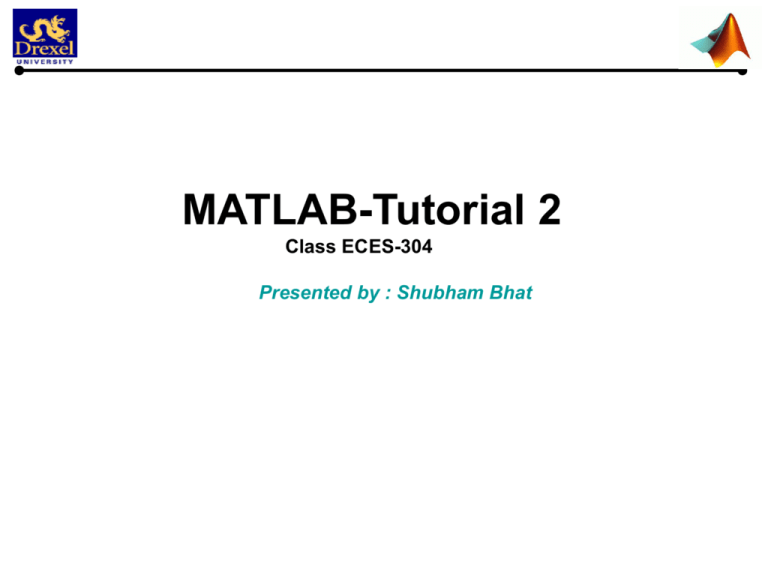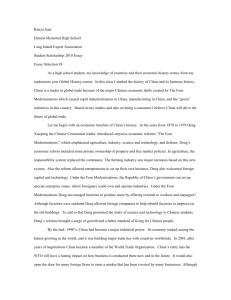Continuous-time transfer functions
advertisement

MATLAB-Tutorial 2 Class ECES-304 Presented by : Shubham Bhat % Nise, N.S. % Control Systems Engineering, 4th ed. % John Wiley & Sons, Hoboken, NJ, 07030 % % Control Systems Engineering Toolbox Version 4.0 % Copyright © 2004 by John Wiley & Sons, Inc. % % (ch2p8) Example 2.3: Let us do Example 2.3 in the book using MATLAB. '(ch2p8) Example 2.3' % Display label. numy=32; deny=poly([0 -4 -8]); [r,p,k] = residue(numy,deny) % Define numerator. % Define denominator. % Calculate residues, poles, and % direct quotient. Creating and handling LTI-models (Linear Time-Invariant) The models supported by CST are continuous-time models and discrete-time models of the following types: •transfer functions •state-space models Creating models We will start with continuous-time models, and then take discrete-time models. •Continuous-time transfer functions The function "tf" creates transfer functions. "tf" needs two MATLAB-vectors, one containing the coefficients of the numerator polynomial - taken in descending orders - and one for the denominator polynomial of the transfer function. As an example we will create the transfer function H0(s)=K0*s/(T0*s+1) K0=2; T0=4; num0=[K0,0]; den0=[T0,1]; H0=tf(num0,den0); % Nise, N.S. % Control Systems Engineering, 4th ed. % John Wiley & Sons, Hoboken, NJ, 07030 % % Control Systems Engineering Toolbox Version 4.0 % Copyright © 2004 by John Wiley & Sons, Inc. % % (ch2p9): Creating Transfer Functions % (1) Vector Method, Polynomial Form: % A transfer function can be expressed as a numerator polynomial divided by a % denominator polynomial, i.e. F(s) = N(s)/D(s). '(ch2p9)' 'Vector Method, Polynomial Form' numf=150*[1 2 7] denf=[1 5 4 0] 'F(s)' F=tf(numf,denf) clear % Display label. % Display label. % Store 150(s^2+2s+7) in numf and % display. % Store s(s+1)(s+4) in denf and % display. % Display label. % Form F(s) and display. % Clear previous variables from workspace. 'Vector Method, Factored Form' % Display label. numg=[-2 -4] % Store (s+2)(s+4) in numg and % display. % Store (s+7)(s+8)(s+9) in deng and % display. % Define K. % Display label. % Form G(s) and display. % Clear previous variables from % workspace. deng=[-7 -8 -9] K=20 'G(s)' G=zpk(numg,deng,K) clear Continuous-time state-space models The function "ss" creates linear state-space models having the form dx/dt=Ax + Bu ; y=Cx + Du As illustrated in the following example: Given the following state-space model: dx1/dt=x2 ; dx2/dt=-4*x1 -2*x2 + 2*u; y=x1 This model is created by A=[0,1;-4,-2]; B=[0;2]; C=[1,0]; D=[0]; ss1=ss(A,B,C,D); To retrieve the system parameters and give them specific names, we can execute [A1,B1,C1,D1,Ts]=ssdata(ss1) % Nise, N.S. % Control Systems Engineering, 4th ed. % John Wiley & Sons, Hoboken, NJ, 07030 % % Control Systems Engineering Toolbox Version 4.0 % Copyright © 2004 by John Wiley & Sons, Inc. % % (ch3p3): The state-space representation consists of specifying the A, B, C, and % D matrices followed by the creation of an LTI state-space object using the MATLAB % command, ss(A,B,C,D). Hence, for the matrices in (ch3p1) and (ch3p2), the % state-space representation would be: '(ch3p3)' A=[0 1 0;0 0 1;-9 -8 -7]; B=[7;8;9]; C=[2 3 4]; D=0; F=ss(A,B,C,D) % Display label. % Represent A. % Represent column vector B. % Represent row vector C. % Represent D. % Create an LTI object and display. Homework Problems % 13. Find the ratio of factors and ratio of polynomials ‘Polynomial form’ Gtf=tf([1 25 20 15 42],[1 13 9 37 35 50]) ‘Factored Form’ Gzpk=zpk(Gtf) % 14. Generate partial fractions numg=[-10 -60]; deng=[0 -40 -50 (roots([1 7 100]))’ (roots([1 6 90]))’]; [numg,deng]=zp2tf(numg’,deng’,1e4); Gtf=tf(numg,deng); G=zpk(Gtf); [r,p,k]=residue(numg,deng); Homework Problems % 10. Write the transfer function in phase variable form ‘a’ Num=100; Den=[1 20 10 7 100]; G=tf(num,den) [Acc,Bcc,Ccc,Dcc]=tf2ss(num,den); Af=flipud(Acc); A=fliplr(Af) B=flipud(Bcc) C=fliplr(Ccc)




